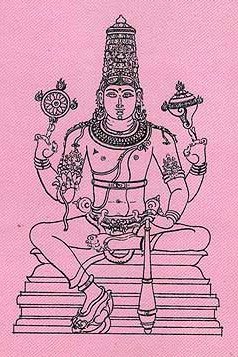Nagabhushana, Nāgabhūṣaṇa, Naga-bhushana: 7 definitions
Introduction:
Nagabhushana means something in Hinduism, Sanskrit. If you want to know the exact meaning, history, etymology or English translation of this term then check out the descriptions on this page. Add your comment or reference to a book if you want to contribute to this summary article.
The Sanskrit term Nāgabhūṣaṇa can be transliterated into English as Nagabhusana or Nagabhushana, using the IAST transliteration scheme (?).
In Hinduism
Pancaratra (worship of Nārāyaṇa)
Source: Shodhganga: Kasyapa Samhita—Text on Visha Chikitsa (p)Nāgabhūṣaṇa (नागभूषण) refers to “one who is adorned by (the eight divine) serpents” and is used to describe Garuḍa, according to the Viṣvaksena Samhitā (verse 26.61) which mentions the efficacy of the Garuḍa-mantra by paying obeisance to him.—It mentions that Garuḍa also renowned as Suparṇa, the king of birds and the illustrious son of Vinatā, is adorned by the eight divine serpents (aṣṭakula-nāgabhūṣaṇa) residing in the seven nether-worlds; his body is smeared with the blood of serpents he has slain. Garuḍa is eulogised as the vehicle of Viṣṇu, who can make the three worlds tremble with his primal strength, and who conquered Brahmā and the other gods (and brought the nectar) to free his mother from bondage:

Pancaratra (पाञ्चरात्र, pāñcarātra) represents a tradition of Hinduism where Narayana is revered and worshipped. Closeley related to Vaishnavism, the Pancaratra literature includes various Agamas and tantras incorporating many Vaishnava philosophies.
Languages of India and abroad
Sanskrit dictionary
Source: DDSA: The practical Sanskrit-English dictionaryNāgabhūṣaṇa (नागभूषण).—an epithet of Śiva.
Derivable forms: nāgabhūṣaṇaḥ (नागभूषणः).
Nāgabhūṣaṇa is a Sanskrit compound consisting of the terms nāga and bhūṣaṇa (भूषण).
Source: Cologne Digital Sanskrit Dictionaries: Aufrecht Catalogus CatalogorumNāgabhūṣaṇa (नागभूषण) as mentioned in Aufrecht’s Catalogus Catalogorum:—Rādh. 46 (and—[commentary]).
Source: Cologne Digital Sanskrit Dictionaries: Monier-Williams Sanskrit-English Dictionary1) Nāgabhūṣaṇa (नागभूषण):—[=nāga-bhūṣaṇa] [from nāga] m. ‘decorated with serpents’, Name of Śiva, [Śivagītā, ascribed to the padma-purāṇa] (cf. -cūḍa)
2) [v.s. ...] Name of an author, [Catalogue(s)]
[Sanskrit to German]
Sanskrit, also spelled संस्कृतम् (saṃskṛtam), is an ancient language of India commonly seen as the grandmother of the Indo-European language family (even English!). Closely allied with Prakrit and Pali, Sanskrit is more exhaustive in both grammar and terms and has the most extensive collection of literature in the world, greatly surpassing its sister-languages Greek and Latin.
Kannada-English dictionary
Source: Alar: Kannada-English corpusNāgabhūṣaṇa (ನಾಗಭೂಷಣ):—[noun] Śiva, who is decorated with serpents.
Kannada is a Dravidian language (as opposed to the Indo-European language family) mainly spoken in the southwestern region of India.
See also (Relevant definitions)
Relevant text
Search found 4 books and stories containing Nagabhushana, Nāgabhūṣaṇa, Naga-bhushana, Nāga-bhūṣaṇa, Nagabhusana, Naga-bhusana; (plurals include: Nagabhushanas, Nāgabhūṣaṇas, bhushanas, bhūṣaṇas, Nagabhusanas, bhusanas). You can also click to the full overview containing English textual excerpts. Below are direct links for the most relevant articles:
Rudra-Shiva concept (Study) (by Maumita Bhattacharjee)
2.19. Rudra as Tryambaka < [Chapter 6a - The Epithets of Rudra-Śiva]
The Shiva Purana (by J. L. Shastri)
Chapter 35 - Śiva-sahasranāma: the thousand names of Śiva < [Section 4 - Koṭirudra-Saṃhitā]
Reviews < [January - March 1974]
Puranic encyclopaedia (by Vettam Mani)